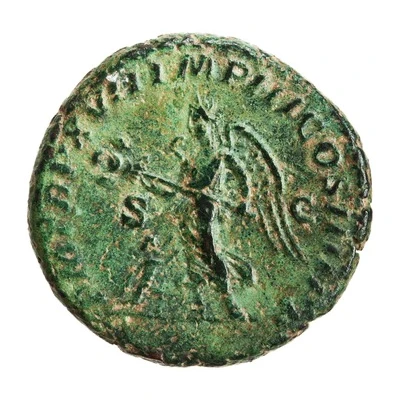


© American Numismatic Society (ANS)
As - Caracalla P M TR P XVII IMP III COS IIII P P S C; Victory
214 year| Bronze | 10 g | 25 mm |
| Issuer | Rome › Roman Empire (27 BC - 395 AD) |
|---|---|
| Emperor | Caracalla (Marcus Aurelius Antoninus Caracalla) (198-217) |
| Type | Standard circulation coin |
| Year | 214 |
| Value | As = 1⁄16 Denarius |
| Currency | Denarius, Reform of Augustus (27 BC – AD 215) |
| Composition | Bronze |
| Weight | 10 g |
| Diameter | 25 mm |
| Shape | Round (irregular) |
| Technique | Hammered |
| Demonetized | Yes |
| Updated | 2024-10-06 |
| Numista | N#273922 |
|---|---|
| Rarity index | 100% |
Reverse
Victory, winged, draped, standing left, holding trophy in both hands; at feet, suppliant kneeling.
Script: Latin
Lettering: P M TR P XVII IMP III COS IIII P P S C
Translation:
Pontifex Maximus, Tribunicia Potestate Septima Decima, Imperator Tertium, Consul Quartum, Pater Patriae. Senatus Consultum.
High priest, holder of tribunician power for the 17th time, supreme commander (Imperator) for the third time, consul for the fourth time, father of the nation. Decree of the senate.
Comment
Mass varies: 8.644–11.09 g;Diameter varies: 24–26.5 mm;
Example of this type:
American Numismatic Society (ANS)
Source:
Online Coins of the Roman Empire (OCRE)
Interesting fact
One interesting fact about this coin is that it features an image of the Roman goddess Victory on the reverse side, which was a common motif on Roman coins during the reign of Caracalla. The image of Victory was meant to symbolize the power and dominance of the Roman Empire, and it was often depicted holding a wreath or a palm branch, as seen on this coin. The use of Victory as a symbol of Roman power and prosperity can be traced back to the early days of the Roman Republic, and it continued to be used throughout the Roman Empire's history.

